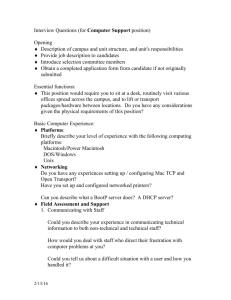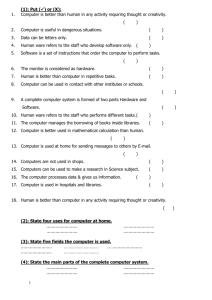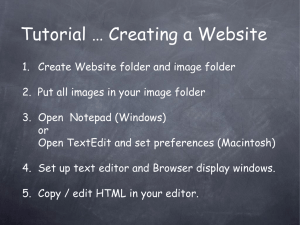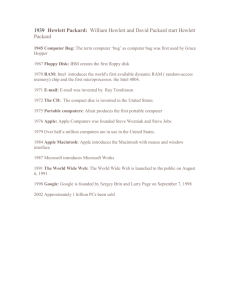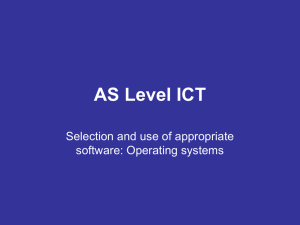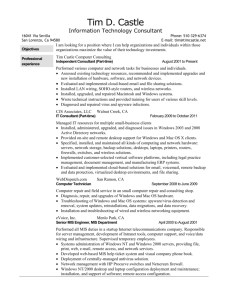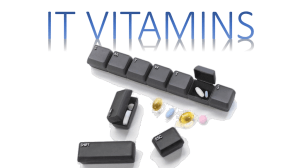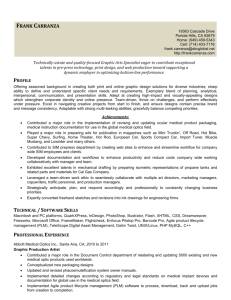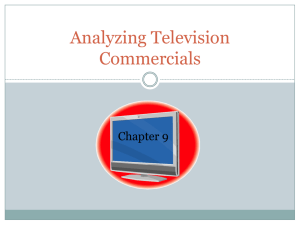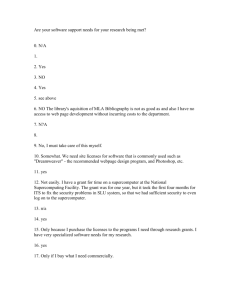Macintosh Selling Guide, 1984
advertisement
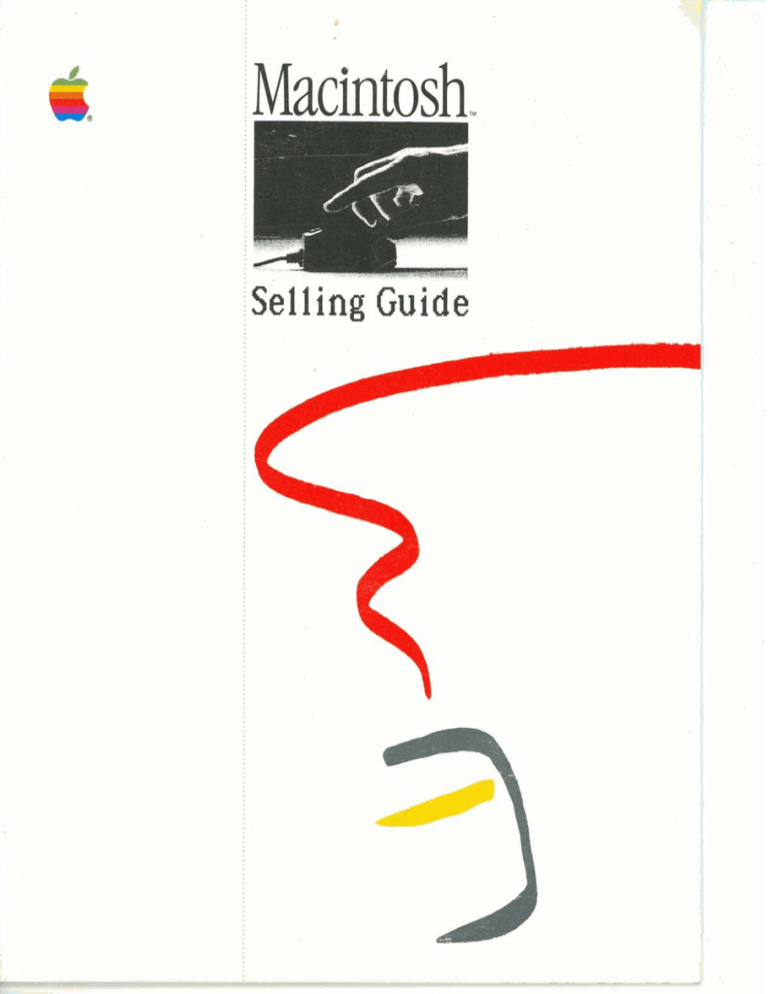
Macintosh,. Selling Guide Macintosh: The Third Industry Standard Macintosh Is for People Knowledge Workers: The Target Market What's So Special Rbout Macintosh? The Macintosh Family Rpple Family Positioning Macintosh Software Demonstrating Macintosh to Business The Macintosh Selling Guide provides a marketing and sales overview of the Macintoshmfamily of products. Its purpose is to help you sell Macintosh to its target market: knowledge workers. The guide shows you how the Macintosh family of computers meets the needs of knowledge workers, and reveals the key to selling Macintosh to this important group of computer buyers. It describes the computers in the Macintosh family and details their advanced capabilities. It discusses those all-important software solutions. And it provides tips on demonstrating Macintosh. In short, it gives you the information you need to sell Macintosh effectively to business. File Macintosh: The Third Industry Standard Apple's marketing goal for Macintosh was simple. To establish Macintosh as the third standard in the personal computer industry. Apple I1 : IRM PC 1981 I Every few years a personal computer IS introduced that establishesa new standard for the industry In 1977, Apple introduced the Apple" I1 personal computer With its incredible versatility and softwarebase, it became the first standard In personal computing. In 1981, IBM introduced the IBM" PC, which became the second standard. In 1984, Apple introduced Macintosh. And it was 1 quickly recognized as the third industry i standard. Key opinion leaders concur: i Analysts I "It's the best thing around." : Esther Dyson, EDventures Holdings i i "This is easily the best price/ j performance machine ever made." Ken Lim, Dataquest, Inc. i J The Press "Fey if any, industry observers expect the Macintosh to be anything but an outstanding success." i Computer World i i i The Software Developers I "Macintosh is much more natural, intuitive, and in line with how people 1 think and work.. .. It's going to i change the way people think about personal computers. . . . Macintosh i sets a whole new standard:' Mitch Kapor, Chairman of the Board, Lotus Development Corporation And the Public "Quite simply, Macintosh is the greatest thing that ever happened to me." Richard M. Rasmussen, Freelance Writer - File ; Macintosh Is t f o r People Most personal computers are aimed : at specific segments af the computer market. : i Product B : Product C I I IJI Market Niches i But Macintosh is different. Because j Macintosh is for people. IJ k l l u u ~ l e u y c :W U I K E l 3. 1 The Taroet M a r k e t flbtruf Msc:ir>tost,'? I'M M?rcintosfr Family $lpyrlc$Fmmilg l>osifirrning Mitcin tostr Sof turmre Elcwmrru trrn tiag Mmr:irrf o$li f 0 ElWi$i$?su Knowledge Workers: The Target Market Specifically,Macintosh is for knowledge workers: people in business, the professions, education, manufacturing, services. What Is a Knowledge Worker? Knowledge workers are easy to spot: they work at desks. They're managers, analysts, planners, consultants, coordinators, supervisors, administrative assistants, even college students. Generall~knowledge workers are people who take information and ideas and process them into plans, reports, analyses, memos, and budgets. Their primary responsibilities are to gather information (retrieve and organize data) B analyze the data (perform numerical analyses) summarize the results of their analyses (write memos, letters, and reports) B prepare and present their conclusions (prepare written proposals, presentation slides, and overheads) That is, knowledge workers solve problems. But perhaps what is more important is this: they take pride in their work. : Knowledge Workers , ................................... 2 9 1 W o r k i n g vith I d e s b Creating documents Analyzing documents Reading '...,. ..." ,.. 46%A t t e n d i n g M e e t i n g s a Presenting idem b Revieving documents b Summarizingresults '25% Other i The Opportunity ; There are approximately 25 million knowledge workers in North America alone, and 95 percent of them don't use personal computers. At $2500 for an average system, that's a potential market of nearly $60 billion. Knowledge Workers .................................. 24 million don't use personal computers 1 million use personal cornputel The Macintosh Market ....................................... : At present, more than 65 percent of j Macintoshes sold go into business. To Increase our share of thls huge market, we must Increase our understandmg of knowledge workers Large Business Qther . Education Home Medium .. .. .. Business ' ' Business 65% s'rn~ll Business What Do Knowledge Workers Need? fast, and easy to use. It must work for them - not the other way around. Knowledge workers move from one acmiity to another throughout the day - from attending a meeting to returning a phone call, from writing a memo to preparing a budget, from reading through mail to making a presentation. In the course of a da): they often need to analyze and combine information from a number of sources. Knowledge workers need a personal computer that can handle all the information that crosses their desks. That can move information from one document to another - from a spreadsheet to a report, for example. That can help them to communicate their ideas effectively- because the presentation counts. They need a computer they do. that works the In short, knowledge workers need Macintosh. The Key to Selling Macintosh , Quality output is Macintosh's "hot button:' Knowledge workers care about their written work - work they use to communicate their ideas. Documents with a clean, professional layout are more compelling. Strong graphic images communicate visually- and effectively Carefully organized and plotted data puts important business information in perspective. See for yourself. You can't create professional-looking documents with most personal computers. At least, not without putting in a lot of time and effort, and memorizing numerous computer commands. 9 With Macintosh, knowledge workers can create documents that look as if they came from a typesetter or a design studio. And they can do it quickly and easily When you make that point to your customers, you'll sell Macintosh. A knowledge worker who adds punch to n one-page memo sells the ~dea ' And knowledge workers sr e busy people. Q n thnir mrnmttor i m~mt 1 A knowledge worker who h~ghllghtskey porn In a spreadtheet communicates A knowledge worker whose repon stands out is I recognized. PROPOSAL: M E W JUNIOR WID(iFI A knowledge worker who gives presentation visuals an extra flair grabs attention. 1 1 What's So Special Rbout Macintosh? File UIIIOI 3 a u JptzLIam Rbout Macintosh? Five key points distinguish Macintosh from other personal computers: Advanced Lisa" Technology 32-Bit Architecture Personal Productivity Tools from Leading Software Companies One Pansportable Box Growth Path i Advanced Lisa Technology Lisa Technology encompmes a wide range of hardware and sofrware : breakthroughs- breakthroughs that : make Macintosh radically easy to i learn and use. Macintah's screen layout resembles a desktop, with pictures of familiar desktop objects. Like file folders. Pads of paper. Even a trash can. With Macintosh, your customers can work the same way they work at their desks. Your customeB use the rnouw to tell mintash what they mt to do. 'They don't have to learn -and remember complex keyboard commands. All operations available for a particular application are alway accessible through pull-down menus at the top of the screen. Again, your c u s t o m don't have to memorize c~nfusing keyboard commands. with Macintosh's mt-md-paste intention, moving information born one application to another is as easy as point, click, cut, and paste. Yaur customers can combine words,numbers, and even pictures-quickly and easfly rn MaeintoskS extramdiinarily lqhresolution bit-mapped display deiivers crisp, clear image of text and graphics. Images that m then be printed just they appear on the screen - in incredible detail And because all Macimah applications take advmtage of the mouse, p i c a m af desktop objects, and pulldown menus, once your customen have lemed one application, they'll fhd it's even easier to leam the next And the next. i 32-Bit Architecture I Macintosh is powerful enough to handle I I the most complex business tasks. i The MC68000, an advanced 32-bit i microprocessor, is at the heart of i I i I i j : I i i i i Macintosh. We've taken the power and i speed of the MC68000 and used it to j set new standards for performance and i ease of use. 4 Macintosh has the memory Macintosh's memory is augmented capacity knowledge workers need. ith 64 kilobytes of ROM, which . The Macintosh 128K can tackle most I contains the pull-down menus, windows, tasks. And can be expanded to a i dialog boxes, and sophisticated graphics Macintosh 512K to handle larger docu- i found in all Macintosh applications. ments and spreadsheets, and to run i Macintosh's ROM gives programmers software that requires more memory i the basis for developing innovative ! applications. And gives your customers i a variety of applications that utilize j the familiar Macintosh format. i I I j i j I I The Macintosh 128K easily handles medium-sized documents and models. As your customers' needs grow they can expand to the Macintosh 512K by purchasing the Memory Expansion Kit (which must be installed by an authorized Apple dealer). In short, Macintosh comes complete m Your customers with larger Inforwith almost everything your customers matlon-processing needs -those who need to start computing. All in a system create large data bases or work w t h that's compact enough and light enough very large spreadsheets - wdl appreciate to go almost anjwhere it's needed. the Maclntosh 512K. rn And for those who push thelr Growth Path equipment to its limits, there's Llsa, the big Macintosh. Macintosh software The Maclntosh family offers your runs on Lisa, taking advantage of customers an established growth path. Lisas larger memory bigger screen, from the Macintosh 128K to the and hard-disk drive. Maclntosh 512K to Lisa. What this means for your customers and you - is that there's a Macintosh for every business need. The Macintnsh Far T h e Macintosh Family Ifeveryonedidthesamething,we'd i need to make only one computer. But i I since managers manage, vice presidents f I preside, and analysts analyze, one i i computer simply won't fit all of them. i i It takes three: the Macintosh 128K, j i the Macintosh 512K, and Lisa. Together I i they're a compatible family of i 32-bit microcomputers that can make i I your customers more productive. In i minutes, not days. i The Macintosh 128K The Macintosh 128K is the entry-level Macmtosh. The Macintosh 128K has 128 kilobytes of RAM and 64 kilobytes of ROM. The ROM contains routines for Macintosh's unique user interface. For your customers, that means more RAM is available for programs and data. The Macintosh 128K is perfect for i I ! i: New users will appreciate the Macintosh difference: no memorizing long, confusing commands, and no guessing what the computer wants. Macintosh is not only a powerful personal computer, but it's also easy to learn and use. As customers' needs grow, they can easily upgrade to a Macintosh 512K. The lower-priced Macintosh offers unparalleled price/performance value. . j The Macintosh 512K The Macintosh 512K is everything the Macintosh 128K is. And then some. The Macintosh 512K has four times the memory of the Macintosh 128K, which means your customers can work on larger documents and models. For example, dramatically larger documents can be created using MacWrite, 10 times more tasks can be entered into a MacProject chart, and thousands of cells can be entered into a Multiplan" spreadsheet. Macintosh 512K users can work wth the most powerful, comprehensive business software being created by independent developers. And the Macintosh 512K is faster. The greater capacity of the Macintosh 512K results in better performance. (Sections of a program are loaded into memory as you work, so the application actually gets faster as you use it.) Access to the Apple Imagewriter or Daisy Wheel Printer - or other printers configured for Macintosh is also faster. . Macintosh Accessories Printers. Apple's Imagewriter printer perfectly reproduces everything on the . Macintosh screen: multiple type styk and sizes, pictures, proportional text, : mixed text and graphics. For formal reports and business correspondence . where words alone suEice, the Apple Daisy Wheel Printer gives letter-quality : results. And for Lisa, there's the Canon color printet: : The Macintosh External Disk Drive. This drive adds another 400 kilobytes of on-line storage to the Macintosh system, eliminating disk swapping and simplifying disk backup. It connects directly to a builkin port at the back . of Macintosh. : The Macintosh Numeric Keypad. Patterned after the accountanti 10-key calculator, the keypad makes fast work . of entering spreadsheet, accounting, and other numerical data. It plugs directly into the Macintosh keyboard. I Apple Modem. With an Apple Modem and communications software like MacTerminal, Macintosh can communicate with other computers and tap . into information services over &inw . telephone lines. The Apple Modem is , available in 300-baud and 1200/300baud models. , ' , ' Apple Cluster Controller and Appleline. For communications with IBM mainframes. there are the Apple and Carrying Case. Macintosh has a rugged carrying case of water-resistant nylon. Inside, padded pockets hold all Macintosh components. Hand and shoulder straps make it easy to take Macintosh almost anywhere. Security Kit. TO secure Macintosh to a d&k or other object, there's the Macintosh Security Kit. Mwrri trisfr: 'i'trr?'i'frirvi inrlw try Sf andsrrl Mrzcin tosh is Irir Periph? #nrx.ufsrfg+?ZIUr,rkws: The I'urrgr4 Mar-kef llrfraf's Ss Specie$ flbouf Mar:intristr? I'tw M W n tosfr Fmmily Apple Family Positioning Rpple Family Positioning Macintosh and Lisa, with the Apple IIc and Apple IIe, give you a hll range of sophisticated computer products to sell. The Apple IIc and IIe are targeted for the home and education markets. Macintosh and Lisa, for the business and professional markets. There is, of course, some overlap in the markets for the Apple I1 family and the Macintosh family Some Apple IIc computers will end up in business; many Macintoshes will find their way into the home. . Nevertheless, you should steer your business customers toward Apple's business computers - Macintosh and Lisa. File I Macintosh Software How do you really sell Macintosh? With software. The success of the Apple I1 was built on its incredible software base. Software was also instrumental in the success of the-IBM PC. Software provides solutions, which are what people need. Macintosh has software - lots of it. And in all that software, the Macintosh philosophy shows. Because Apple and software developers have done the hard work, your customers don't have to. Macintosh software features pulldown menus, windows, dialog boxes, and the familiar pictures of desktop objects. So it's easy to learn and easy to use. Let your customers see it. MacProject. Your custamm can use this comprehensive project management tool to schedule and track any kmd of project MacProject calculates the start and finish d a t for ~ each task as well as for the entire praject, displays all critical paths, and instantly recalculates the entire prsject based on a change In, any flhase. It also displays resaurce 1 an Apple Cluster Controller enable Macmtosh to emulate IBM 3278 terminals. Your customers can use MacTerminal to transfer documents, applications, even pictures between Macintosh and other computers, : or Macintmh Pascal,Macintosh BASIC, the Macintosh 68000 Development System (assembly language), give progammers the tools they need to cteate heir own programs. O W -Dl*# - Y e # 'Tlmlunlt ldispi -truncwggO . : Third-Party Solutions Software for Macintosh is really new and different - not just rewrites of old 22 programs. Apple set the example with MacWrite and Machnt (packaged with all Macintosh computers). Hundreds of independent developers like Microsoft, Lotus, and Stoneware followed suit, taking advantage of Macintosh's mouse, pull-down menus, dialog boxes, graphics, and cut-and-paste integration to create innovative solutions to every possible business need. ' Amount of Software Time More than 150 software products were created for Macintosh in its f i t year alone. List magazine's special issue of The Macintosh Buy& Guide (November 1984) covers more than 200 of the quality hardware and sohare products currently available. For the future, Apple's support and encouragement of independent developers ensures a steady flow of new software products - and of new solutions for your customers. I to Business U C I I I U I I ~ ~at111ymaL.1lntua11 I Demonstrating Macintosh to Business I Macintosh is a solid business computer with something extra: state-of-the-art graphics. With Macintosh, knowledge workers can accomplish their work well and make that work communicate through quality graphics. Your demonstrations should show the full power of Macintosh as a business tool. Macintosh has great business solutions. Emphasize the diversity of business programs available and the variety of developers providing applications for Macintosh. Use MacWrite or Microsoft" Word to show Macintosh's wordprocessing capabilities. Bring out Multiplan for spreadsheets, and Microsoft Chart for business graphics. Talk about data bases with Filevision: PFS": File and Report, and DB Master? You may want to keep examples of business graphics, spreadsheets, and so on in the Scrapbook to give your customers an overview of Macintosh's business applications. Macintosh is for business. Show that in your Macintosh demonstrations. i Giving an &pert Demonstration : Your demonstration should emphasize these four points: 1. Macintosh has a tremendous variety ; of programs. Knowledge workers can get all their work done on one computer Macintosh. 2. Macintosh is for business. And it . has s o h r e that meets the needs of . your business customers. : 3. All Macintosh applications work : the same way, using the mouse, pulld m mmus, cut-and-paste inkgration, and so on. So learning the first application is e a q And learning the next application is even easfes. : 4. Many ~acintoshprograms can share information - even if thefre from different companies. You can, for example, move data from fyple's Mackoject into Microsoft's Multiplan for analysis. : : ' , - i Before demonstrating an application, take the time to become thoroughly ' i familiar wlth it -what it does and : how it works. To help you learn the applications and how to demonstrate them, Apple has created a series of . videotapes called The &pert Demo ; Sen& (available from your Apple . representative). The videotqes cover . 41the major business applications: ward processing, graphics, spreadsheets, data I ~ ' I . . . . comunications, project management, and more. The first five videotiyes cover the fouowing topics: I.Word processing (new version of MacWrite and MacPaint) 2. Graphics (MacDr@ 3, Fmject management (MacProject) 4. Data communications (MacTerminall 5, Integrated applications : Demonstrating Integrated ' Applications 1 Integration - the ability to move infor- 26 mation from one Macintosh application to another - is particularly important to your business customers. Consider this scenario: In a typical day, a knowledge worker may need to handle a variety of projects. That means updates to proposals, schedules, spreadsheets. and memos. And a time change or budget increase for one part of a project can affect the entire project. Putting together changes in project diagrams and expense tables, using a spreadsheet to create a budget, and summarizing the results in memos can take a lot of valuable time The key goals for knowledge workers are to do their work faster and more efficientla and to give an presentation of the results. In your demonstrations, show how Macintosh makes quick work of preparing and changing - reports, spreadsheets, and so on. And then show the quality of Macintosh'soutput, Before giving a Macintosh demonstration, ask your customer about his or her typical day; Then tailor the demonstration to the customer's needs. Here are a few hints: w Keep a variety of applications on hand so you have the application for each customer. MacProject might be best for one customer; Multiplan, for another; and MacWrite, for yet another. Stress Macintosh's built-in integration tools: the Scrapbook and the Clipboard. Use each one at least once, I : pointing out its usefulness to your customer's specific needs Save special "scraps" in the Scrapbook. You may want to create a business letterhead, for example, and pull it out to show how to personalize a business letter or invoice. Couch your demonstration in terms Admiliar to your custorner. Use a story or scenario tailored to the customer's business - one that he or she will accept as an everyda): believable situation. During a good demonstration, most of the conversation should set the scene and be aimed at getting the customer to agree that the applications are worthwhile solutions to real business problems. (You'll lose your customer if you spend time explaining the keystrokes you're using.) ' IultiPlan Microsaft Chart Your demonstration might go something like this: 1. Start with a MacProject schedule. Show how a time and expense change to some small task in the project will affect the entire project. Copy a section of the new MacPmject expense table to the Clipboard. And copy the MacProject chart (or part of it) to the Scranhook. , Paste the Clipboard contents into a Multiplan spreadsheet of a department's current projects. Show the effect of the changes on the total department. Copy the new totals section to the Clipboard. 5. Do a business graph by pasting the Clipboard contents into Microsoft Chart, Add titles and labels to the graph, and then copy the graph to the Clipboard. MacWrito .. Delete Resource. -. . . . select nil XR MacTerminal MacTwrnmal 4. Use MacWrite to compose a memo detailing all your changes. Copy the MacProject chart from the Scrapbook into the memo. Then add the Microsoft Chart graph to your memo. At the top of the memo, you may want to include a MacDraw or MacPaint letterhead stored in the Scrapbook. 5. Use MacTerminal to get data from The Sources" or the Dow Jones News/ Retrieval" service. Paste the data into your memo. Or have several Macintoshes hooked together and sen. your memo to another Macintosh. (This is optional.) Macintosh Mans Busin ' The best way to sell Macintosh into the huge business market is with business-oriented presentations. Demonstrations of Macintosh's business applications, for example, are a great way to show Macintosh's capabilities. And they can help you determine the right Macintosh - the Macintosh 128K, Macintosh 512K, or Lisa 2/10 - for a specific customer The bottom line Macintosh is for business. To sell Macintosh into thts important market, talk business and show Macintosh's unique business applications ' sllppage~all come from the leadmy uendor In the field, Blue Co. It is becwmmmg apparent l o me that we may have put la0 much (01th m Ine leadlng uendor and the success of our ProJect may suffer lor it. I enclose s graph to demonstrate the degree or our dependence. Our Uendor Edtt Commands ssttlngs Phone Keypad 1 : fill graphics wera created using MacPaint i on the Macintosh. Apple Computer, Inc. 20525 Mariani Avenue . Cupertino, California 95014 (408)996-1010 TLX 171-576
